Table of Contents
6
Natural Fibres
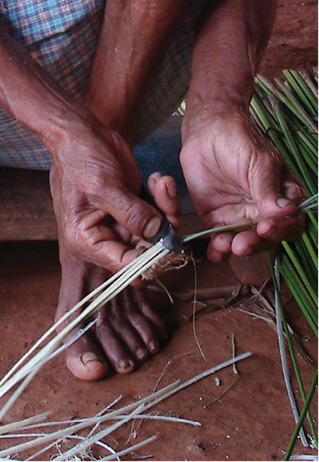
Fibre made from the edible banana plant is used in weaving the traditional Japanese fibre cloth called bashofu. The cloth is smooth, stiff and is used in making the kimono, the traditional Japanese dress.
The craft of extracting fibre from the banana plant, spinning the yarn, weaving it into cloth and patterning the cloth was a highly valued craft of the Okinawa Islands.
Japan has an ancient tradition of crafts that were renowned throughout the world for their elegant sophistication. World War II, rapid industrialisation and urbanisation in Japan, in the last century, threatened this artistic heritage. The younger generations were hesitant to continue the family traditions in the twenty-first century, the age of computers and television.
It was then that the government started a new scheme and great artists, who excel in the area of crafts and creativity, are honoured with the title of ‘Living National Treasure’ in Japan. Scholars, visitors and students are encouraged to explore, research and study with these masters. This is a wonderful example of how today the Japanese value their craft traditions and honour the great practitioners of crafts.
How This Craft Started

A traditional Japanese kimono
Communities living in diverse climates and harsh terrains have creatively responded to the challenges of their environment by transforming locally available natural fibres to create a large variety of objects necessary for their survival.
The ingenuity of community artists created a great variety of natural fibre products. The products range in both scale and form — from large architectural creations of homes and shelters, suspension bridges and fences to smaller objects: baskets, mats and hand fans.
The bamboo and cane crafts of the North Eastern region of India represent a large storehouse of forms and traditional wisdom. The forms of several baskets have evolved as a response to function, as seen in examples such as the open-weave baskets of Mizoram which are flexible and allow the person to carry firewood, while the close-weave baskets of Garo hills in Meghalaya are used to transport and store rice grains. Other forms of baskets have been determined by culture or in responses of different communities.
What Is a Natural Fibre?
Natural fibres made of cellulose or plant matter can be obtained from almost every part of the plant such as the root, stem or shoot, leaf, fruit and bark from many tree species (see following table).

Banana fibre
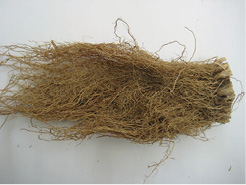
Khus fibre
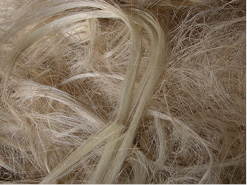
Sisal fibre

Fibre can be extracted from a leaf which is fibrous, pliable, strong and green. If the leaf can be wound around a finger without breaking, then it indicates a potential source for making fibre.
Beauty of Natural Fibres
Natural fibre products have certain distinctive qualities: they share a common language of colour, texture and of belonging to the earth. The appearance, feel, and texture of a bamboo basket is clearly different from that of a plastic bag. No two bamboo baskets are of the same colour while they could have the same form. A woven surface, like a reed mat, could have many shades of white or brown. Leading fashion houses today search for such beauty as lies in asymmetry, irregularity and natural warmth.
Fibre: filament or thread of a natural or synthetic material that can be spun into yarn
Fibres are obtained by shredding or peeling parts of plants, or pounding them to make threads or by cutting them to make strips.
Fibres from plants pre-date cloth woven from yarn spun from cotton. Ancient communities must have used natural fibres to build shelters and thatched roofs.
Qualities of Natural Fibres
Different fibres have varying physical properties of strength, appearance, pliability, colour, texture and fragrance.
Traditional skills and knowledge of working with these materials is an economic activity, often undertaken as an additional activity, to earn a little extra income when there is a break in the agricultural cycle of work.
Roots
Khus or ramacham in Malayalam (Vetiveria zizaniodes) is the aromatic root of a densely tufted grass. The grass has a thick root system which helps in checking soil erosion. It is thus an excellent stabilising hedge for stream banks, terraces and rice paddies. Khus grass grows wild in many states but is cultivated in Rajasthan, Uttar Pradesh, Punjab, Kerala, Karnataka, Tamil Nadu and Andhra Pradesh.
Khus is known for its fragrance and cooling properties. The roots are used for making mats, beds, and pads for desert coolers. The dried stems are used for making brooms, fans, hats and footwear, and for thatching.
Stems
A great variety of baskets, mats and floor coverings are made from grass and reed fibres which are referred to in local languages as moonj, sarkanda, kora, sikki, chipkiang, madur kathi, rice straw, kauna reed. Reeds grow naturally in marshy land and in ponds.
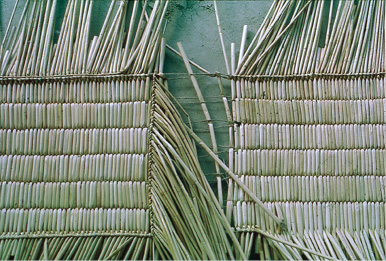
Unfinished reed mat, Manipur
Kauna is the local name for a reed or rush belonging to the family Cyperaceae which is cultivated in the wetlands of the Imphal valley. It has a cylindrical, soft and spongy stem which is woven into mats, square and rectangular cushions and mattresses by the women of the Meitei community of Manipur. The raw material for the craft is obtained by simple processing wherein the reed is cut near the base of the plant and dried in the sun. It is also smoked if it is to be preserved and stored for a longer time. The mats are woven by interlacing the stalks with jute threads using basic and simple tools. The mats and cushions have a unique edge finishing which is done by hand.
Korai (Tamil Nadu) or kora (Kerala) also of the Cyperaceae family is a sedge or wetland plant which is cultivated in the southern districts of Tamil Nadu. The stems are cut near the base of the plant, spliced vertically and dried in the sun. On drying the spliced stems curl into a smooth and tubular form. A large variety of mats—with stripes, geometrical motifs, natural and dyed colours—are woven in several districts of Tamil Nadu and Kerala. The mats are woven on horizontal floor looms. The ribbed natural coloured mats are popularly used as floor coverings.
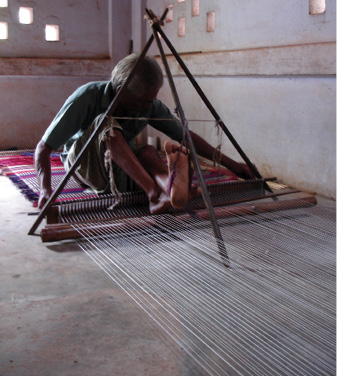
A kora mat weaver on the traditional loom, Tamil Nadu
In Midnapur District of West Bengal, another type of reed similar to kora called madur kathi (Cyperus corymbosus) is cultivated, harvested and processed. Finely spliced madur is woven into mats that have a central field enclosed by patterned borders. The weavers ingeniously use two subtly differentiated natural colour splits or selectively dyed parts of the splits to differentiate the borders with dyed colour. Both the loom and the weaving technique used are very basic but require the use of manual skills and craftsmanship rather than sophisticated equipment and technology.
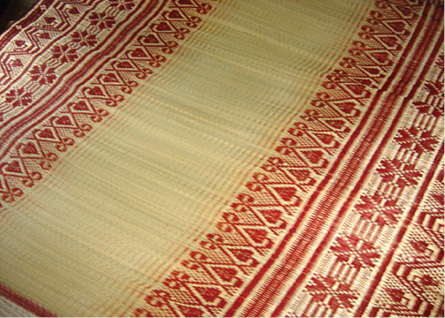
Shital pati, Assam
Unlike the woven mats, shital pati or ‘cool mats’ made by the plaiting technique are made in Assam and Tripura. The mat has a smooth and lustrous surface. The murta plant or (Maranta dichotoma) is harvested when green, washed in soda water and dried. It is then boiled and sliced into strips for plaiting the mat.
In Uttar Pradesh and Bihar women make baskets using the technique of coiling. These compact containers are made for local use with spliced moonj or sikki grass stalks. The trays and shallow containers are used to store foodgrains and flour. Moonj baskets with multi-coloured fibres and bold patterns are made for a daughter’s trousseau.
In the Madhubani District of Bihar, women make figurines of deities, animals and birds for ritual and everyday use with sikki or golden grass used in combination with multi-coloured dyed stalks. The imagery of these forms echoes the folk art of Mithila, the cultural region on the northern banks of the Ganges.
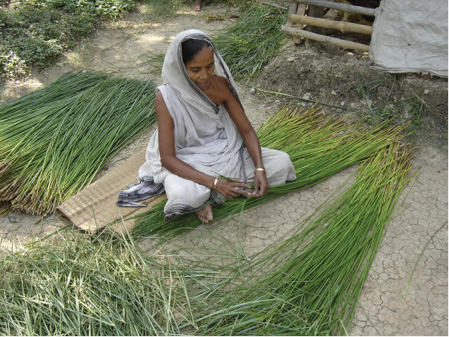
Mat weaver separating the stem of the sedge or kathi from the leaf stalk,West Bengal
Strips obtained from the palm leaf are also used to make coiled baskets and containers in Haryana. A bunch of moonj grass fibres forms the core material of the coil and a palm leaf strip is wound over the coil and binds consecutive rows of coils in place.
Furniture items such as the mooda or stools are examples of elegant products made entirely from natural fibres such as sarkanda and moonj. Sarkanda is a wild grass found in Haryana and its long stems are used in making the indigenous mooda.
Bamboo is a giant tree-like grass which mostly grows wild in the tropical and sub-tropical regions of the world. Bamboo is significant as a renewable resource that is found abundantly in India. These tall grasses have straight, woody and cylindrical stems, which have nodes. Some stems are hollow and some are solid. These cylindrical stems or culms taper at the top. The nodes at the top have branches with leaves and flowers. Bamboos grow closely in clumps. There are 136 species of bamboo in India. The botanical name is bambusae.Bamboos grow quickly—60mm to 200mm in a day and some species grow up to 900mm in a day. It is a widely used material that is hardy, durable, economical and biodegradable.
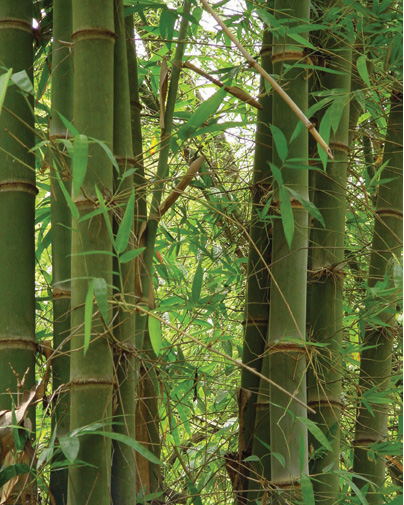
Bamboo is used whole as well as split in different widths to make a large range of products. Simple tools like a dao or bill-hook knife or wide-bladed knife are widely used for making splits. Bamboo has long fibres running along its length and the bond between the fibres is relatively weak while the fibres themselves are extremely strong. This structural characteristic affords easy splitting along the length.
Bast fibres are generally long fibres. Consequently they are used in making yarn and weaving cloth
Local communities use this characteristic in an appropriate manner while devising different products.
Jute, a stem or bast fibre, is cultivated in West Bengal. Jute cloth is brittle and deteriorates with exposure to sun and rain. It has been popular as inexpensive packaging material. In the craft sector, today, there is a renewed interest in finding innovative applications of jute such as fashion accessories, bags and wall panelling using macramé, crochet, braiding and other non-woven techniques.
Detail of a contemporary wall panel made with jute yarn using macramé or knotting technique
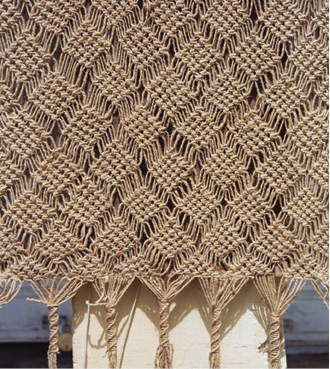
A large variety of baskets, containers, mats and furniture are made from the leaves and stem of trees and plants belonging to the palm family.
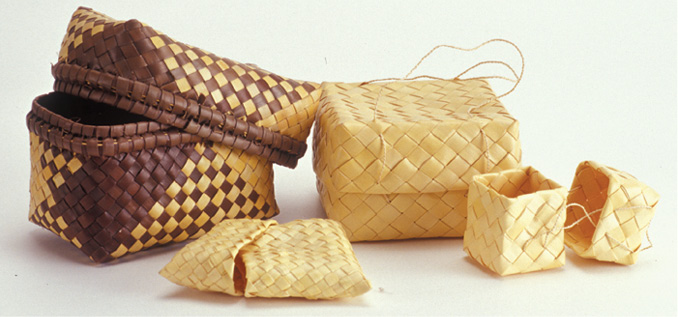
Boxes made of palm strips for various uses
Palm trees are commonly found in the coastal regions of India and some varieties like the date palm grow in semi-arid regions. While coconut, arecanut and date palm trees have feather like leaves, the palmyra or toddy palm has fan-like leaves.
The local population of coastal Tamil Nadu is known for judiciously using every part of the palm tree for a wide range of applications—the trunk is used in local architecture and for making rafts; the leaves are used whole as roof thatch and wall panels while strips are woven into baskets, winnowing trays and for packaging fish and jaggery. Palm oil and palm fruit are edible products.
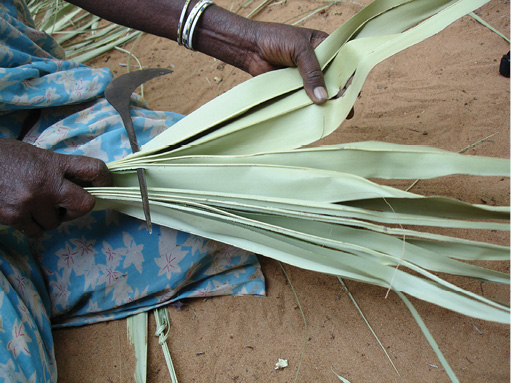
An artisan making strips of the palm leaf by inserting a knife in the leaf fold and separating the leaf from the midrib
Cane is an important forest produce found mainly in north-eastern parts of India. It is cylindrical and of uniform thickness, solid and brown in colour. Its properties of being tough, flexible and elastic have made whole cane suitable for use in furniture, hats, walking sticks, fishing rods and baskets. In Arunachal Pradesh even suspension bridges are made of cane.
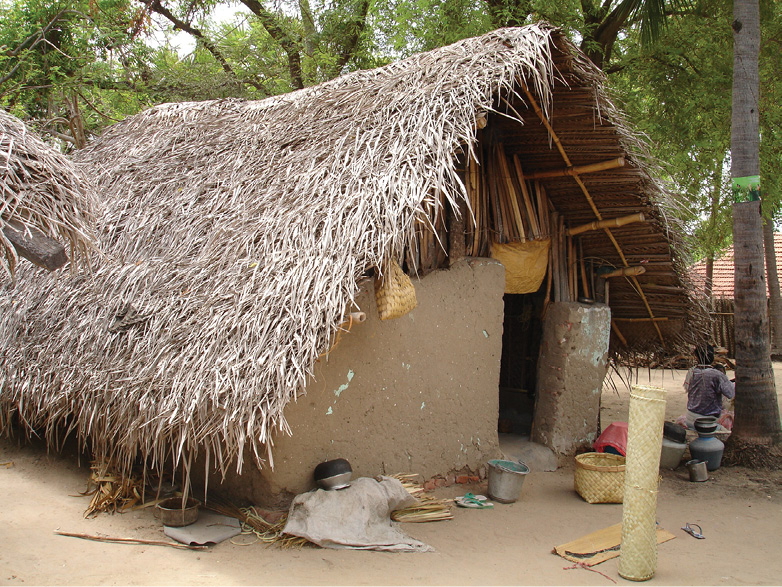
A palm-leaf craftsman’s house, Tamil Nadu
Cane splits are used for tying and binding, and are especially used for finishing the rims and edges of baskets due to their smoothness and pliability.
Canes are long slender stems of climbing plants which belong to the palm family. India has about 30 species of cane growing in Assam, Arunachal Pradesh, the Andamans, Nagaland, Manipur, Mizoram, Meghalaya, Kerala, Karnataka and Tamil Nadu.
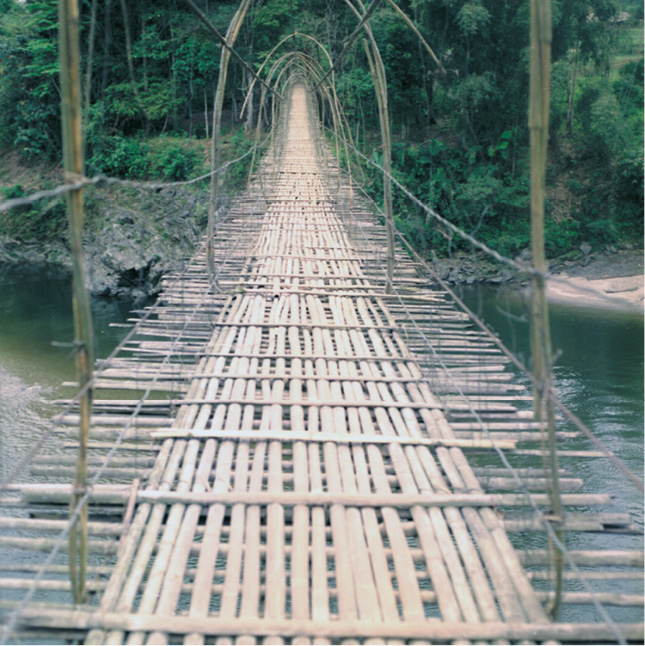
Cane-and-bamboo suspension bridge over a torrential river in Along, Arunachal Pradesh
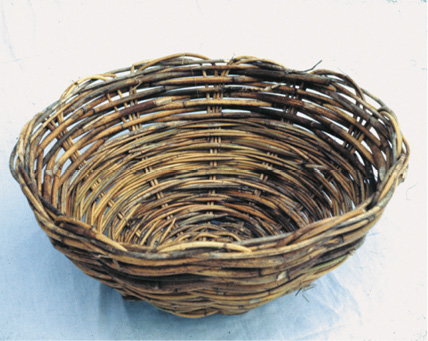
A shallow circular basket made from whole cane
Cane furniture made by skilled craftsmen, Nagaland
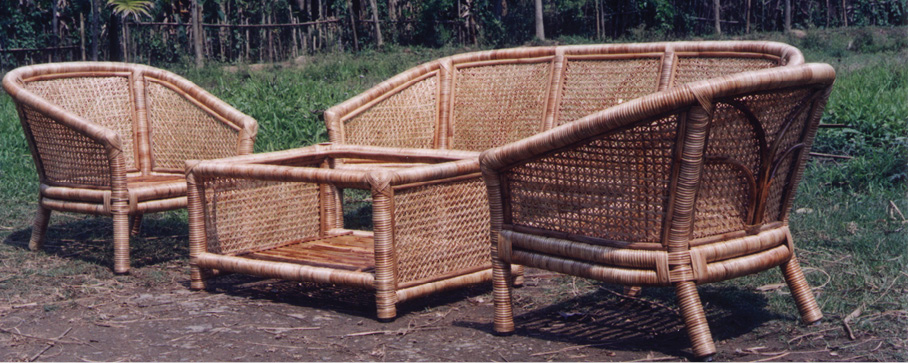
Fruit
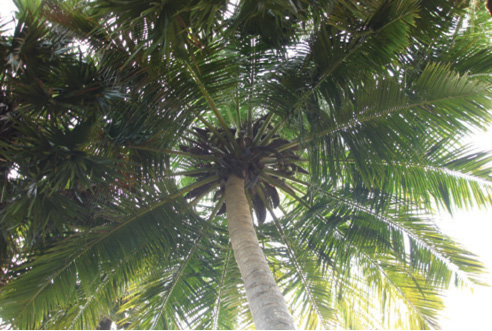
The coconut palm tree grows wild.
The coconut palm tree also has multiple uses of its stem, fronds, fruit and nut. Coir fibre extracted from the outer husk of green coconuts is spun into yarn and ropes while the fibre of brown coconut is used as stuffing in mattresses. Coconut husks have to be retted or steeped in water to loosen them from the tough husks. Coir producing villages are located in the backwaters habitat of Kerala which abound in the skills of processing and spinning coir and of weaving coir floor coverings. White coir extracted from the green husk is of superior quality and withstands salt corrosion. It has wide-ranging applications, for instance, in ship-building and for making floor coverings.
Leaf
The screw pine is a tropical plant known for its soil conservation properties. It is grown as a hedge or as a boundary wall in Kerala. It is available in abundance and provides a source of income to rural women who make strips from the leaves to weave mats. The leaves are also used as roof thatches. Strips are interlaced diagonally to weave mats and large surfaces that are then cut and sewn to make containers, bags and hats.

Coir fibre
There are male and female species of the screw pine. The female screw pine produces a finer quality of fibre used in weaving traditional mats called mettha pai which are soft and cool to sleep on. The male screw pine produces coarser fibre. In Thazava in Kollam district of Kerala, double layer mats are made which are edged with a vivid coloured strip used to stitch the layers together. The white mat is burnished with a stone that gives it a polish.
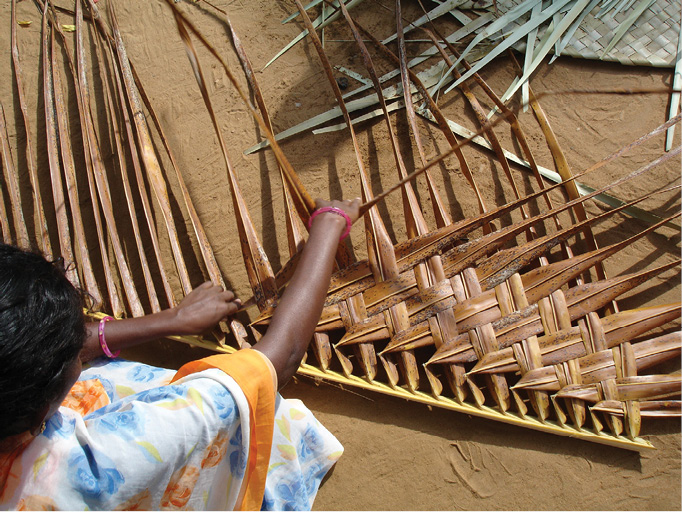
The pinnate or compound leaves being woven together
All the World in a Basket
A basket, that common object of daily use, can powerfully affect the sense and mind — somewhat as the contemplation of a grain of sand can lead to insights on the nature of the world.
What appeals first is the visual texture, that distinctive aspect of baskets, arising from this definitive quality of being woven. We delight in the patterns and textures made of rope, leaves, grass, rushes, sticks or twigs or other similar material. We may instinctively run our hands over the surface: an understandable reaction because texture, whether physical or visual, is a quality of surface.

Traditional bamboo craftspersons, Orissa
On seeing baskets we feel one with humanity: however rich or poor or highly formally educated or illiterate we may be, from virtually any part of the world and, indeed, from almost any era — we can relate to the basket. Together with pottery, basketry is one of the oldest human crafts. Gathering material from the natural environment, and making from it a receptacle useful for the storage and transportation of objects; a receptacle designed for ease and comfort of use as relating to the human anatomy — what an act of creative transformation this is!
However, our admiration of the quantities of the design is often directed at a group rather than an individual — who knows which anonymous craftsperson added an innovation which was later refined, preferred and adapted by many? Particular types of baskets do gain associations with particular regions and cultures, such as the conical basket of the apple gatherers in the Kullu valley, and the basket of the Kangri pot which could even be regarded as a symbol of Kashmir.
Bamboo craft practised by both men and women is a traditional and hereditary source of livelihood for several people in the states from Gujarat in the west to Assam in the east, and Uttar Pradesh in the north to Kerala in the south.
Another human and social point is an economic one: when one buys a traditional basket it is more likely that the sale would benefit not a factory owner or company but an individual who is possibly not wealthy and is working with a greater degree of autonomy such as by being a member of a cooperative.
Baskets may be considered desirable today from an ecological point of view, being made from fast growing plant materials used without much processing (hence saving energy). The production of baskets does not require energy — and resource-rich factories or processes; and baskets are bio-degradable and hence less polluting.
– Deepak Hiranandani, The Times of India,
28 May 2001

Functional products made of ekra bamboo by the Khasis of Meghalaya
Worldwide Use of Natural Fibres
The importance of papyrus, a fresh water reed in ancient Egypt is evident from its primeval origins. Papyrus is a tall flowering reed and its use is functional and religious and was part of the mythology of ancient Egypt. Papyrus had multiple uses—from paper for manuscripts to papyrus boats that were the lifeline of the River Nile, sails were made from the bark, seams of the larger wooden boats were caulked with papyrus, rigging was made of papyrus fibres and papyrus flower was a sacred symbol of the pharaohs.
The Mbuti Pygmies living in the Ituri forests of Equatorial Africa are hunter-gatherers known for their knowledge of plants for multiple uses—as food, shelter, medicine, furniture, weapons, poison for hunting, as cloth and dyes.
Eskimos in Alaska and communities in the islands of the Pacific Ocean such as Tonga, Samoa, Hawaii, Papua New Guinea, Fiji and New Zealand, produced bark-cloth by a repeated action of beating strips of bark of the fig tree. When the strips are thin, several strips are taken together and beaten into a large sheet. Sometimes starch was applied in parts to join the strips. Tapa or the barkcloth of Tonga is painted using a stencil that is cut from the midrib of the coconut frond.
In Europe, North America and Alaska mats are made of grass, rush and sedge; baskets are made from split wood, shoots of hard wood trees, willow, wicker and barks of trees.
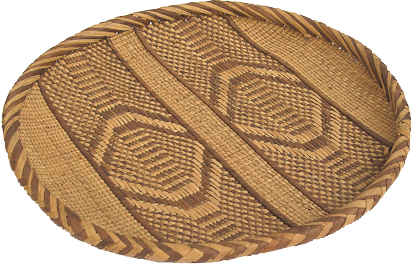
The grasslands of South Africa provide material for coiled basketry while wetlands provide reeds and rushes for mats; deserts are the home of agaves or succulent cacti, tropics for palms and cultivated land for straw.
In the cold and temperate forests of North America and Europe, the barks of the birch tree and hardwoods of deciduous trees are used as slats in basketry.
In the tropical and sub-tropical regions of Asia, Africa and South America, the jungles are a rich source of bamboo and cane, which provide bamboo and leaves for building shelters, tools and implements for agriculture, fishing and the daily needs of settled communities.
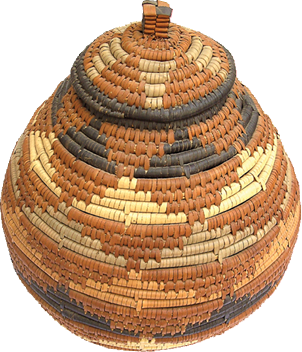
Coiled basketry made of grass fibre or palm leaf fibre is found in Morocco, East Africa, India, Ghana, Mexico, Bolivia, Guatemala and islands of the Pacific Ocean. Ceremonial baskets and headwear are often formed by techniques such as coiling, twining, plaiting and are embellished with feathers, shells, coins and a bold use of pattern and colour.
The use of bamboo in Bangladesh, Burma, South-East Asia, China and Japan is very extensive and is integral to the culture of the East.
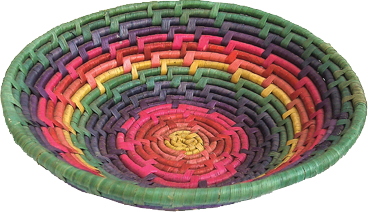
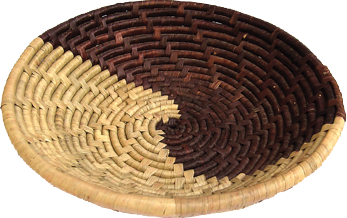
1. All cultivated plant materials as well as those found in the wild in our forests are potentially renewable resources that can be used for a large number of applications if their use by humans is moderated in a sustainable manner. Compare and apply the principle of sustainability in three craft traditions — stone, metal and natural fibre.
2. In your opinion what differentiates plastic objects from objects made of natural fibres?
3. What are the qualities and properties of natural fibres and how have these properties been used in craft? Explain with examples.
4. Refer to the Internet and describe the use of natural fibres in one Asian country.
5. The conversion of forest land into agricultural and industrial areas has led to problems for the bamboo crafts community in India. Develop ideas that can help solve these problems.
6. Draft a scheme that you would like to start in India to elevate our craft traditions and honour the great practitioners of crafts.
7. What is the impact of the intrusion of plastic ware into rural and urban homes? (Think of the following: the rural economy, traditional crafts and skills, environment and health.)
8. Unlike clay and stone, basket-making is not a full-time profession. Compare and contrast and give reasons why this is usually the case.